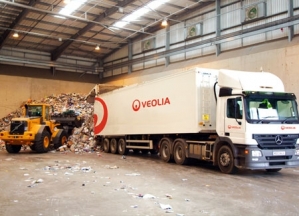
Cash Saving Innovation for Veolia
26/03/2015 - posted in Buildings, Geoenvironmental, HBPW News, Industrial, Value Engineering
Veolia in Operation
Innovative engineering for one of the world’s leading waste recovery companies resulted in significant savings thanks to a practical approach to overcoming challenges on two sites in Nottinghamshire.
Clugston Construction has been charged with the construction of two UK based waste transfer stations for Veolia, the French owned company which operates across the globe, employing more than 300,000 people worldwide.
And, when HBPW was asked to become the lead designer for its large shed-like schemes in Newark and Worksop, in the East Midlands, it was an opportunity to prove that value engineering really can make a difference to the bottom line.
Partner, Emyr Parry, said: “Both sites are very similar, each comprising large steel clad buildings, one measuring 75mx45m and the other 60mx40m. Both have a history of industrial use, meaning that innovation was necessary if we were to accommodate and retain on site.”
Soil contaminated from historical use can be costly to transport off site so careful planning of ground levels at both locations ensured that little if any removal of soil was necessary.

One man’s rubbish is another’s treasure!
There was also the need to consider Sustainable Drainage Systems (SuDS) for the new facilities. Planning Conditions for both schemes meant that any water flowing from the sites would need to be restricted to less than the existing flows, through use of water attenuation.
“Typically this involves excavating soil to install large underground holding tanks so that in the event of a heavy downpour, water can be collected, stored and subsequently drained away into existing sewers in a more controlled way.
“Rather than do this, we chose to design above ground water storage on top of the surrounding external yards. By having the external yards set to gradients that effectively form large ponds, it now means that in the event of a heavy rain storm water is stored ‘on top’ of each yard.
“Effectively an area of each site becomes temporarily flooded, but in a controlled manner, meaning operations at either of the facilities, or their neighbouring properties, are not effected. Also, by removing the need for large excavations for underground tanks, the removal of potentially contaminated soil from the site has also been avoided.”
Statistically both sites have enough storage to deal with the worst possible downpour within a 100 year period.
“Each of the developments not only represents a further expansion for Veolia, but also emphasise, yet again, the international requirement for the saving and recycling of valuable resources. It’s good to know that our design has played its own part in taking cost out of yet another project,” added Emyr.
Around the globe, Veolia helps cities and industries to manage, optimise and make the most of their resources. The company provides an array of solutions related to water, energy and materials with a focus on waste recovery.

Life’s rubbish!
